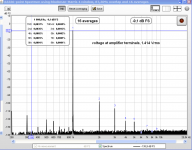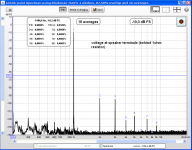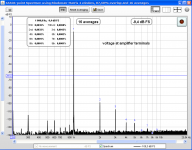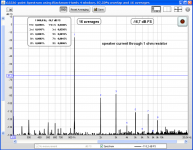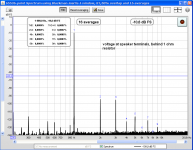This was 3-way. Vrms <2V
Results are quite consistent with different speakers.
There is a rule, 3-way has less distortion than 2-way and 2-way less than fullrange. Smaller woofer has higher LF distortion than bigger woofer.
Thank you PMA, and using a horn will give less distortion compared to a usual 3-way speaker...
Using your 2-way/3way/fullrange as synonymous - and the digital sources - we can avoid distortion if we use less amplifiers.... which means building the linestage into the power amplifier and use only a passive volume attenuator / TVC (i.e. 600 ohm) as volume control.
I proposed this some (hundreds) postings earlier...
I have shown voltage at speaker terminals. I assume that if I measured current flowing into the speaker, the situation might be different. Now the task, to measure speaker current with high resolution and precision.
The speaker current should reflect speaker non-linearities in the spectrum.
As expected, speaker current shows higher distortion than speaker voltage. This is a highly improvised setup, so please forgive not so clean measurements as my standard is.
The speaker is connected via 1 ohm resistor to amplifier speaker terminals.
1) voltage at amplifier terminals
2) current through 1 ohm resistor (voltage drop across resistor)
3) voltage at speaker terminals (behind 1 ohm resistor)
(-10dB tap/divider was used for voltage measurements, no divider for current measurement)
Attachments
Last edited:
So even with voltage drive that is free of higher harmonics, the speaker will add its own distortion. This distortion may be observed in speaker current rather than in speaker voltage. This investigates speaker electrical non-linearity and mechanical non-linearity transferred to electrical side only. Then, we have acoustical sources of speaker distortion.
Sorry I am not going to provide you with tens plots, it is useless. Theories from a land of phantasy would always appear even if thousands of measurements were posted.
Think of your real audience here as the serious people, don't worry about the babbling from gasbags. Appreciate your work.
http://www.diyaudio.com
diyAudio is a place for all members of the DIY audio community to learn, share knowledge, and enjoy interacting with others interested in the design and construction of audio components. This privately owned forum reserves the right to limit the behavior of its members. The rules will be enforced in good faith to maintain discussion quality and peer respect.
THE RULES
NOT ALLOWED:
- Insulting, intimidating, bullying, harassing or other disrespectful or antisocial behavior.
Pavel,
Your two distance measurement confirms your microphone is clean. ( I had assumed you were using a used precision microphone and I have yet to see one of those that didn't need cleaning.).
Now the increase in distortion at greater distance is to some part due to the non linear behavior of air. PV=NRT pretty much holds but as mentioned there are commercial products that use ultrasonic transducers and the air to produce highly defined audio band reproduction. I would expect the air issues to be 40db down or more.
Now as to the additional issue of distortion, please go back and read the method of cleaning microphones. I suggested SY and Scott use compressed air, no one else, they got the joke.
I do have a test chamber and microphones so when I get to it I will try to calibrate some transducers.
However your use of reciprocity to look at the current drive is the start of a very good method. Should be interesting to see how it gets applied.
Your two distance measurement confirms your microphone is clean. ( I had assumed you were using a used precision microphone and I have yet to see one of those that didn't need cleaning.).
Now the increase in distortion at greater distance is to some part due to the non linear behavior of air. PV=NRT pretty much holds but as mentioned there are commercial products that use ultrasonic transducers and the air to produce highly defined audio band reproduction. I would expect the air issues to be 40db down or more.
Now as to the additional issue of distortion, please go back and read the method of cleaning microphones. I suggested SY and Scott use compressed air, no one else, they got the joke.
I do have a test chamber and microphones so when I get to it I will try to calibrate some transducers.
However your use of reciprocity to look at the current drive is the start of a very good method. Should be interesting to see how it gets applied.
As expected, speaker current shows higher distortion than speaker voltage. This is a highly improvised setup, so please forgive not so clean measurements as my standard is.
The speaker is connected via 1 ohm resistor to amplifier speaker terminals.
1) voltage at amplifier terminals
2) current through 1 ohm resistor (voltage drop across resistor)
3) voltage at speaker terminals (behind 1 ohm resistor)
(-10dB tap/divider was used for voltage measurements, no divider for current measurement)
I have repeated the same measurement, with some loop issues fixed. The numbers are consistent and the 1st measurement is confirmed. Speaker current shows more distortion than speaker voltage. The speaker produces high harmonics at considerably higher level than those arriving from an amplifier.
Attachments
I get the distinct impression that "trolling" in some people's heads equals "a POV that they're not comfortable with, that is not part of the clique belief system". If that's a criminal offense I would be happy that to see where that is specified in these parts.I would refer the honorable gentleman (#60176) to rule 2.
For me, it includes trying to divert whatever thread you are in to your own agenda.
You are averaging 7 posts a day and they are effectively all the same!
Cliff
You are averaging 7 posts a day and they are effectively all the same!
Cliff
Let's see, that appears to be an agenda of discussing what's needed to achieve high quality playback, along with trivia about recordings - so I take it that such is not a fit concept to be discussed in this forum? Would you prefer me to talk about how to select a stain finish for speaker boxes to match one's home decor, perhaps?
Frank, you never come with any evidence, only repeated general statements, highly subjective. You would be surprised to see distortion of PC speakers.
I'm sure you know exactly what I'm talking about!
Simply start your own thread and you can discuss your ideas ad nauseum and the rest of us can chose, or not, to participate.
Simply start your own thread and you can discuss your ideas ad nauseum and the rest of us can chose, or not, to participate.
Ok, so what happens when you use a slightly distorted test signal ?.I have repeated the same measurement, with some loop issues fixed. The numbers are consistent and the 1st measurement is confirmed. Speaker current shows more distortion than speaker voltage. The speaker produces high harmonics at considerably higher level than those arriving from an amplifier.
Ie, add particular harmonics of the fundamental tone at variable phase wrt the fundamental tone ?....easily do able with the likes of Cool Edit.
Or, feed a sawtooth wave, normal or inverted polarity ?.
Add some low level sub 20Hz 1/f noise ?.
Just a few permutations for you there, I'm sure we can think of more while you have your test jig up and running.
Dan.
I did some measurements with added 2H, 1% and 3H, 1%, several years ago. It only confuses the issue.
The fact is that: speaker is nonlinear, speaker impedance at speaker electrical terminals is nonlinear. Even if driven with pure sine signal, speaker current is distorted. Distortion depends on driver and cross-over design. It is inevitable. Speaker distortion may be reduced with current drive, but then we have to equalize frequency response. Only poorly designed amplifiers will add its distortion to speaker inherent distortion. Examples are well known, but I do not want to start unnecessary turmoil. I assume that many people know what designs I speak about.
My observation is that people not necessarily seek for lowest distortion. Opposite is often true, and some people are looking for amplifiers with distortion profile that would effectively mask speaker inherent distortion. It is not a question of money or product name, it is a question of listeners taste and fashion. Similar applies to vinyl and tape. They are both sources of high distortion and limited dynamic range. Thus imperfect recordings are tolerable with vinyl and tape.
The fact is that: speaker is nonlinear, speaker impedance at speaker electrical terminals is nonlinear. Even if driven with pure sine signal, speaker current is distorted. Distortion depends on driver and cross-over design. It is inevitable. Speaker distortion may be reduced with current drive, but then we have to equalize frequency response. Only poorly designed amplifiers will add its distortion to speaker inherent distortion. Examples are well known, but I do not want to start unnecessary turmoil. I assume that many people know what designs I speak about.
My observation is that people not necessarily seek for lowest distortion. Opposite is often true, and some people are looking for amplifiers with distortion profile that would effectively mask speaker inherent distortion. It is not a question of money or product name, it is a question of listeners taste and fashion. Similar applies to vinyl and tape. They are both sources of high distortion and limited dynamic range. Thus imperfect recordings are tolerable with vinyl and tape.
Pavel, on a forum any "evidence" is very shaky, numbers taken in any circumstances which are not 100% monitored by some impartial 3rd party, etc, mean very little, especially if a person is pushing some agenda.Frank, you never come with any evidence, only repeated general statements, highly subjective. You would be surprised to see distortion of PC speakers.
Of course the PC speakers have high distortion - you have just demonstrated significant levels in what I would imagine are pretty decent units. But, some distortion is far more significant, subjectively, than other types - for more complex reasons then the usual measurements indicate.
As an example, at the recent audio I heard Dynaudio speakers: an upmarket model, and also a few more middle of the range. The "better" one was absolute superb to listen to, and the others were rubbish, I would have put a screwdriver or two through them to stop the noise, if I was forced to keep listening. So, had the manufacturer created some brilliant speaker drivers and then some junk to fill out the range ... or was there something more to it ... ?
Last edited:
I have repeated the same measurement
Pavel
Thank you again for showing your work.
Can you tell me what is the FSD (0dB) of the Amp Out screen shot in Volts? (I am trying to back calculate speaker impedance)
George
Are you saying that imperfect recordings on CD, reproduced on a "perfect" amplifier, and "perfect" speakers, will not be tolerable?Thus imperfect recordings are tolerable with vinyl and tape.
Pavel
Thank you again for showing your work.
Can you tell me what is the FSD (0dB) of the Amp Out screen shot in Volts? (I am trying to back calculate speaker impedance)
George
George, amplifier voltage and speaker voltage are measured with same gain settings. From speaker voltage measurement you may read -10.6 dBFS and from amplifier voltage you may read -9.4 dBFS. The difference is 1.2 dB. Series resistor was 1 ohm, so now you are able to calculate speaker impedance. The divider rule says that speaker impedance is about 6.6 ohm at 1 kHz.
OK, calculator better than my head, 6.75 ohm 😀
Last edited:
- Status
- Not open for further replies.
- Home
- Member Areas
- The Lounge
- John Curl's Blowtorch preamplifier part II
